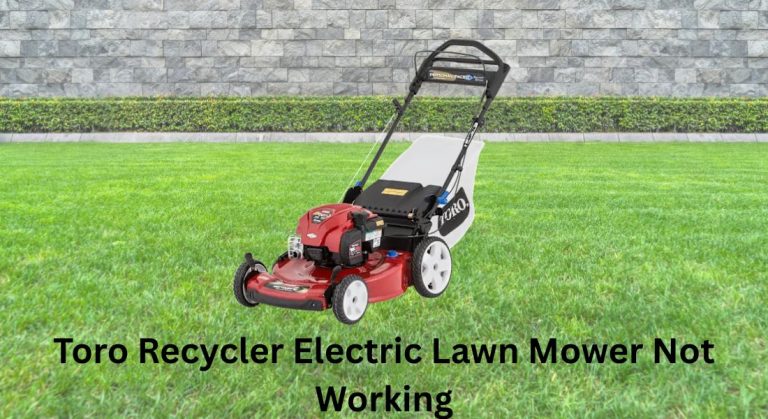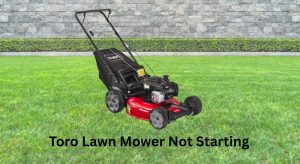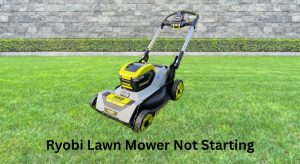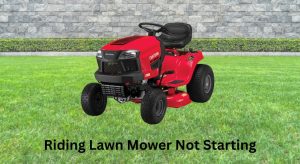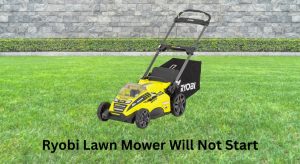Your Toro Recycler electric lawn mower won’t start—or it suddenly stops mid-cut—and you’re stuck with an overgrown yard. Frustrating, right? The good news: most “Toro Recycler electric lawn mower not working” issues come down to simple things like a tripped breaker, safety handle switch, battery connection, or clogged deck. A quick fix to try first: disconnect power, remove the bag, tip the mower backward (spark-free if corded; battery removed if cordless), and clear packed grass from the blade area and discharge chute. Then check the safety bail/handle is fully engaged while starting.
In this guide, you’ll get a complete troubleshooting framework for Toro Recycler models—both battery-powered and corded electric. We’ll cover common causes, fast diagnostics, multiple repair methods, and how to prevent issues in the future. By the end, you’ll know exactly how to get your Toro running again safely and reliably.
Common Causes of a Toro Recycler Electric Lawn Mower Not Working

- Safety bail switch not engaged or faulty: The handle lever must be fully pulled to close the circuit.
- Battery issues (cordless models): Low charge, loose battery, overheated pack, or failing cells.
- Power supply problems (corded models): Tripped breaker, bad extension cord, or faulty outlet.
- Blade obstruction or clogged deck: Grass buildup prevents spin or triggers overload protection.
- Wet or tall grass overload: Motor protection trips due to excessive resistance.
- Key/insert missing (specific models): Some battery models require a safety key.
- Faulty start button or control module: Worn or damaged components after heavy use.
- Damaged wiring or connectors: Loose, corroded, or pinched cables.
- Motor overheated: Thermal cutoff engages; mower won’t run until it cools.
- Dull or bent blade: Adds load, causes stalls and repeated shutdowns.
How to Fix a Toro Recycler Electric Lawn Mower Not Working
Before you begin:
– Important: Always remove the battery on cordless models or unplug the corded mower before inspecting the blade or deck.
– Wear cut-resistant gloves and eye protection.
– Work on a flat, dry surface.
Method 1: Quick Safety and Power Checks
Diagnosing the Issue
- Symptoms: No response when pressing start, intermittent start-stop, or shuts off quickly.
- Goal: Rule out the simplest power and safety interlock errors.
Fix Steps
- Verify model type:
– Battery models (e.g., Toro 60V Recycler): Remove the battery; check charge level on the battery LEDs.
– Corded models: Confirm the outlet works by plugging in another tool. - Check the safety bail/handle:
– Pull and hold the handle lever fully to the bar. If the cable feels slack, adjust the cable at the handle bracket. - Inspect the start control:
– For push-button models, press and hold for 2–3 seconds while holding the safety bail.
– For key-operated models, ensure the key is inserted and fully seated. - Power source:
– Battery: Reseat the pack until it clicks. If warm, let it cool 15–30 minutes.
– Corded: Use a 12–14 gauge outdoor-rated cord (max 100 ft). Reset GFCI outlets and home breakers. - Check for overload trip:
– If the mower shut off mid-cut, wait 10–20 minutes for the thermal cutoff to reset.
Testing
- Reconnect power, hold the safety bail firmly, then start. If it still won’t start, proceed.
Method 2: Clear Obstructions and Reduce Load
Diagnosing the Issue
- Symptoms: Humming sound but no spin, stalls in heavy grass, shuts off after a few seconds.
- Likely Cause: Grass/that choked under deck or caught around the blade; dull/bent blade increasing load.
Fix Steps
- Disconnect power (battery out or unplug).
- Tip the mower backward onto its rear wheels; avoid tipping sideways to prevent moisture/oil ingress.
- Inspect the blade and deck:
– Remove packed wet grass from the deck and discharge chute.
– Check for rope/string or debris wrapped around the blade shaft. - Blade check:
– Ensure the blade bolt is tight (typically 35–45 ft-lb—check your Toro manual for the exact spec).
– Inspect for bends, chips, or severe dullness. Sharpen or replace if needed. - Height adjustment:
– Raise the cutting height one or two settings to reduce load. - Grass conditions:
– Avoid wet grass; mow when dry. Take narrower passes in tall grass.
Testing
- Restore power and test on a small dry patch. If it runs but stalls later, proceed to Method 4 for maintenance and load reduction strategies.
Method 3: Battery and Electrical Diagnostics (Cordless and Corded)
Diagnosing the Issue
- Symptoms: No lights on the battery, battery flashes error, starts only with a different battery, cord gets hot, or GFCI trips.
Fix Steps (Battery Models)
- Battery health:
– Press battery indicator. No lights or a single flashing LED can indicate low charge or fault.
– Charge fully (60–120 minutes depending on pack). If charger shows error lights, consult the charger label. - Battery temperature:
– If hot after mowing, cool 15–30 minutes before reuse or charging. - Reseat and inspect:
– Clean battery contacts with a dry cloth; look for corrosion or bent pins. - Try another pack:
– If you have a second compatible Toro 60V battery, test with it. If mower works, the original battery may be failing. - Charger check:
– Test battery on another charger if available. If charger is dead (no lights), replace the charger.
Fix Steps (Corded Models)
- Extension cord:
– Use a heavy-gauge (12–14 AWG) 3-prong outdoor cord. Avoid daisy-chaining cords.
– Replace any frayed or warm cords. - Outlet and breaker:
– Test a different outlet on a different circuit. Reset GFCI. - Cord retention:
– Ensure the cord is fully seated and routed through the cord retainer so it won’t unplug during use.
Testing
- After charging/reseating and cord checks, start the mower. If it still fails, the issue may be with the handle switch, control board, or motor.
Method 4: Inspect and Adjust Safety Switches and Controls
Diagnosing the Issue
- Symptoms: You pull the bail, press start, and nothing happens; mower runs only when holding the bail at an odd angle; intermittent cut-out on bumps.
Fix Steps
- Cable tension:
– Follow the control cable from the bail lever to the mower body. If slack, adjust at the handle bracket to remove play. - Bail switch:
– With power disconnected, examine the bail switch housing at the handle. Look for cracks or loose screws. - Connector check:
– Follow the cable to the control module; firmly reseat any quick-connect plugs. - Safety key (if equipped):
– Ensure the key is fully inserted; wiggle slightly while attempting to start (then seat firmly).
Testing
- Reconnect power and test. If it starts but cuts intermittently, continue to Method 5.
Method 5: Deep Clean, Dry, and Prevent Overheating
Diagnosing the Issue
- Symptoms: Works for a few minutes, then stops until cooled; weak performance in damp conditions; frequent thermal shutdowns.
Fix Steps
- Deck cleaning:
– Scrape the deck clean to improve airflow and reduce motor load. - Airflow/drainage:
– Ensure rear bag vents or mulching plugs are clear. - Dry time:
– If you recently washed the mower or cut wet grass, let it dry in a warm, ventilated area for 12–24 hours. Moisture in switches can cause faults. - Ambient temperature:
– Avoid mowing in extreme heat; give the mower rest intervals in heavy grass. - Blade maintenance:
– Sharpen or replace the blade for efficient cutting. A sharp blade significantly lowers motor load.
Testing
- Mow a small test area at a higher deck height. Gradually lower if performance is stable.
Method 6: Advanced Checks (For Experienced DIYers)
Warning: These steps may void warranties. Proceed only if you’re comfortable and your mower is out of warranty.
Diagnosing the Issue
- Symptoms: All basics checked, still no-start or consistent cut-outs. Possible motor/controller fault.
Fix Steps
- Continuity of bail switch:
– With a multimeter, test the bail switch for continuity when engaged. - Battery voltage (cordless):
– Check open-circuit voltage with a multimeter. Significantly below rated output after charge indicates a failing pack. - Connector and harness:
– Inspect wiring for pinched, rubbed, or corroded sections near the handle pivot and deck entry points. - Motor spin test:
– With power disconnected, rotate the blade by hand (gloves on). Resistance, scraping, or wobble suggests bearing or motor issues. - Controller:
– Some Toro models have a control module under the deck or near the handle junction. Look for burnt smells, heat discoloration, or moisture.
Testing
- After repairs or replacements, reassemble carefully and test under light load.
How to Prevent Future Starting and Stalling Issues
- Keep the deck and discharge chute clean after every use.
- Sharpen the blade every 20–25 hours of mowing or each season.
- Store batteries at 40–60% charge in a cool, dry place; avoid leaving on the charger long-term if the manual advises against it.
- Use the right extension cord gauge for corded models.
- Avoid mowing wet grass; raise deck height for tall growth and make slower passes.
- Periodically check cable tension and fasteners on the handle and deck.
Pro Tips
- Start on a trimmed edge: Begin mowing on lighter grass to let electronics ramp up before heavy patches.
- Two-pass strategy: For very tall lawns, do a high-pass cut first, then a lower pass.
- Battery rotation: If you have two Toro 60V packs, rotate them to prevent deep discharge and heat buildup.
- Keep a deck scraper handy: A plastic or wooden scraper prevents damage to the deck coating.
- Torque matters: Use a torque wrench on the blade bolt to factory spec to avoid vibration and motor stress.
- Dry storage: Store the mower and battery off the ground in a dry, cool location to reduce corrosion and moisture faults.
- Extension cord discipline: For corded models, keep cord fully extended and off the blade path; use the cord retainer to prevent unplugging.
When to Call a Professional
- Persistent no-start after battery/cord, switch, and deck checks.
- Visible arcing, burning smell, melted connectors, or water intrusion in the control module.
- Motor grinding, seized blade hub, or excessive vibration even with a balanced blade.
- Battery swelling, leaking, or repeated charger error codes.
- Under warranty: Contact Toro or an authorized service center to avoid voiding coverage.
Typical costs:
– Blade replacement/sharpening: $15–$40
– New extension cord (12 AWG outdoor): $40–$80
– Toro 60V battery (varies by Ah): $120–$250
– Handle switch/cable assembly: $20–$60
– Professional diagnostic/labor: $60–$120 per hour
Warranty notes:
– Batteries and chargers often have separate warranty periods.
– Opening sealed motor/controllers can void warranty—check your owner’s manual.
FAQ
Q: Why does my Toro Recycler start and then stop after a few seconds?
A: This often indicates overload or thermal protection. Clear the deck, raise the cutting height, sharpen the blade, and ensure the battery is fully charged or the cord is heavy gauge. Let the mower cool 10–20 minutes and try again.
Q: My battery shows full, but the mower won’t run. What now?
A: Reseat the battery, clean contacts, and test with another battery if possible. Check the safety bail switch and cable tension. If a second battery works, the original pack may be faulty.
Q: Can I mow wet grass with an electric Toro Recycler?
A: It’s not recommended. Wet grass increases load and clogs the deck, causing stalls and potential moisture issues in switches and electronics.
Q: What extension cord should I use for a corded Recycler?
A: Use a 12–14 AWG outdoor-rated cord, ideally no more than 100 feet. Lighter cords cause voltage drop, overheating, and weak performance.
Q: How do I know if my blade is the problem?
A: Signs include ragged cuts, heavy vibration, and frequent stalling. Remove power, inspect for nicks/bends, and sharpen or replace as needed. Ensure the bolt is torqued to spec.
Q: The mower won’t start after I cleaned it. Did I damage it?
A: Moisture in switches or connectors can prevent starting. Let it dry for 12–24 hours in a warm, ventilated area. Avoid pressure washing; use a brush/scraper instead.
Q: Is there a reset button on Toro electric mowers?
A: Many models rely on electronic thermal protection rather than a manual reset. If it stops, waiting for cool-down and reducing load typically restores operation.
Alternative Solutions
Sometimes repair isn’t practical, especially with aging batteries or failed controllers. Consider these options:
| Solution | Pros | Cons | Best For |
|---|---|---|---|
| Replace battery pack | Fast, restores power | Costly; pack wear over time | Cordless users with weak runtime |
| Switch to corded use (if you own both types) | Unlimited runtime | Cord management hassle | Small yards with nearby outlets |
| Upgrade to newer Toro 60V Recycler | Improved efficiency, runtime, features | Higher upfront cost | Frequent users, larger lawns |
| Professional service | Expert diagnosis | Labor costs, downtime | Complex electrical/motor faults |
Get Your Toro Recycler Working Again
You now have a complete plan to fix a Toro Recycler electric lawn mower not working:
– Quick checks for power, safety bail, key, and cords
– Deck clearing and blade maintenance to reduce load
– Battery/charger and outlet diagnostics
– Switch, wiring, and advanced troubleshooting steps
– Prevention tips to avoid future stalls and no-starts
Follow these methods in order, and you’ll likely restore your mower without a trip to the shop. Still stuck? Share your model and symptoms in the comments for tailored advice.
Found this helpful? Bookmark it for your next mowing day—and keep your Toro Recycler electric lawn mower running smoothly all season.

